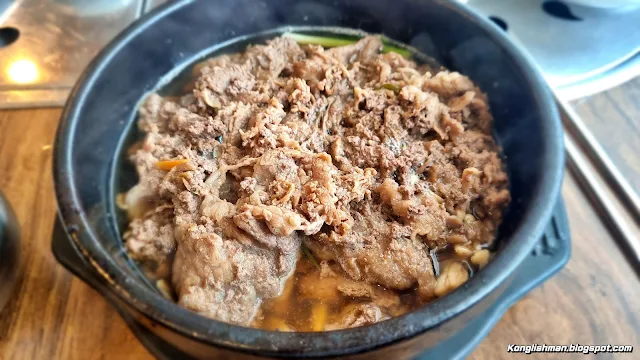Korean Bulgogi Stew served in a bowl
A Ttukbaegi is a porcelain bowl. In this bowl, put pork bulgogi, vegetables, and broth and boil to make a bowl of ttukbaegi bulgogi. Cooking methods and ingredients are determined by the restaurant. So, even if the same ttukbaegi bulgogi has different ingredients and nutrients, the taste will be different. Just like if the ingredients for a hamburger are different, the taste will be different. So, it's fun to find a restaurant that makes Ttukbaegi Bulgogi delicious and become regulars. Last time I blogged about this restaurant. This is my second visit to eat this food, and I'll tell you what I couldn't finish last time.
A large amount of Bulgogi in a Ttukbaegi at the 미가원 Migawon
Ttukbaegi Bulgogi cooked by the chef of Migawon Steak Restaurant. There was a lot of pork bulgogi in the bowl. Other restaurants often use a 4:6 pork to vegetable ration. But I love the 8:2 meat/vegetable ratio here. The Bulgogi is lean, not chewy, not thick, and tastes great. It was the most delicious bulgogi I have ever eaten.
Vegetables and steak(meat)are in harmony in Korean food
It is one of the Korean food culture to eat vegetables uncooked. In particular when eating meat, it is typical to make ssam with vegetables. Pick up a piece of bulgogi with chopsticks, put it on top a lettuce leaf, put ssamjang sauce and garlic on top, wrap the lettuce leaf and enjoy. If you eat only one piece of meat at a meal and one piece of meat with several vegetables and feel the difference in taste, you will know the true taste of Korean food. Then, dip the non-spicy green chilli in ssamjang and eat it with a bite. Feel the taste of nature!
A bowl of rice and side dishes
Just as Westerners eat bread or milk for breakfast, lunch, and dinner, rice and side dishes are staple foods for Koreans. The whether in Korea is hot, humid, and it rains a lot, so it's an environment in which rice grows well, Rice is perfect for carbohydrate intake and there are many vegetable side dishes as plants grow well.
Korean food is mostly salty or spicy food that is not sweet and Kimchi and diced kkakdugi are typical. The upper right image is squid sashimi on top of a perilla leaf. The taste is slightly spicy and salty, and I could feel the texture of squid sashimi. The green side dish below it is pickled chwinamul and the taste is not salty and the texture is similar to spinach, but a little bitter.
The first image at the bottom is cabbage kimchi. One piece of kimchi was so big that it was put in my mouth, so I had to cut it with chopstick and eat it. Kimchi is made by fermenting cabbage in salt and seasoning, putting it in a Jangdokdae and aging it for a long time. Aged kimchi is rich in lactic acid bacteria, which aids in digestion and makes the stomach healthy. The process of making kkakdugi is similar to that of making kimchi. Eating a lot of spicy food is not good for health, but I would like to say that the spicy taste of kimchi or kkakdugi is fine. So, Korean chefs who make good food adjust the spiciness of kimchi or kkakdugi to normal.
The texture was good and you can enjoy the fresh taste at this restaurant in the Migawon.
Korean Steak House, Ttukbaegi Bulgogi, Bucheon Migawon Restaurant, How to Eat Korean Food, Korean Restaurant Recommendation, How to Enjoy Korean Food, A delicious restaurant with Ttukbaegi Bulgogi, 뚝배기 불고기 먹는 방법, 한식 먹는 방법, 한식집 추천, 뚝배기 불고기 맛집, 뚝불 맛집,




Comments
Post a Comment